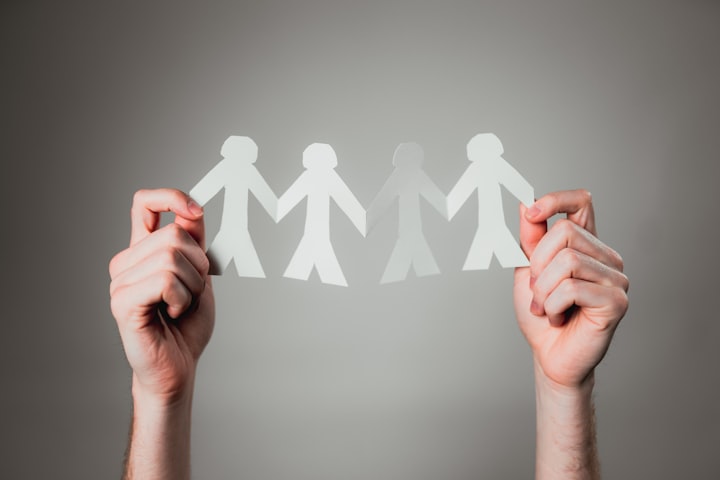The Three Groups of People We Like to Imitate
“We imitate the habits of three groups in particular: The close. The many. The powerful.” — James Clear

There are three important groups of people in our lives that influence us to varying degrees. And whether we like it or not, they create the thoughts that we think, the emotions that we feel, and the actions that we take.
The three groups of people are:
- The Close
- The Many
- The Powerful
So, let’s look at each one more closely to see why we follow them and the impact they have on us both individually and collectively.
The Close
Who we surround ourselves with most often ultimately determines who we become. It’s inevitable.
That’s because thoughts produce emotions and emotions drive actions. So, over time, neural pathways in the brain naturally continue to make us think the same thoughts, feel the same emotions, and act the same behavioral patterns. This then becomes our personal reality or our personality.
“You are the average of the five people spend the most time with.” — Jim Rohn
Typically the closest people in our lives are family members, friends, sports team members, or work colleagues. However, they can also be pets, trees, flowers, authors, podcasters, musicians, the stars, and the spirit world.
It doesn’t really matter if they are visible or invisible. What matters is how they make us feel physically, mentally, emotionally, and spiritually and how that then affects the thoughts that we think, the emotions that we feel, and the behaviors we act out.
We can’t underestimate the influence of the people closest to us.
The Many
Humans have been masters at following The Many ever since we wanted to roam in larger and larger numbers as a species. As each band of humans grew in size, communities developed. As communities developed, societies formed. As societies formed, nations grew. As nations grew, continents emerged. And as continents emerged, the world connected.
With each new step, there were more and more people to see, learn from, and listen to. This created popular modern cultures like fashion, sport, film, travel, commercialism, and the like.
This also created conflict too. Cultures often clashed, beliefs were often questions, and new ways of communicating and connecting needed to be learned (fast!).
Most people follow The Many for three reasons:
- It’s trendy and inclusive
- Fear and/or repression
- It’s easy
We humans can’t resist being included. We’re hard-wired for inclusivity. That’s why the many are so powerful. We all want to be a part of what’s trendy and popular.
However, the sad truth about following the many is that it’s normally through fear, scaremonger tactics, repression, and/or violence. Epic wars, huge invasions, the rise and fall of empires, and the obliteration of culture, tradition, land, and first people are all proof of this.
That’s why it’s easier to follow the many and why most societies, governments, and nations do it. It might not be what they want to do but it’s often easier than creating conflict.
The biggest trouble with this approach, however, is that years can go by with many people choosing the easy option only to find themselves waking up to a world they don’t agree with or know how they got there.
The German people knew all about that.
Now, for some good news…
The special thing about following the many is that it also works on the opposite end of the spectrum. The power of the collective is so vast and enormous that miracles have been performed through a small concentrated number of individuals all vying for the same goal.
“Prayer groups are the hotbed of miracles” — Allan Gierran
So, even though religions have taken their share of criticism (and rightly so), the notion that millions of people come together to practice and serve a greater good has had an enormous ripple effect throughout history.
Whether we choose mob mentality or group prayer is, of course, a personal and collective decision. Whichever way it goes though, both work in the same way: They produce a collective field that governs each individual within that collective radius and it’s far stronger than any individual.
The Powerful
The powerful can take many forms but they usually arise in two ways:
- Fear, violence, repression
- Inspiration
Adolf Hitler, Pol Pot, and Vladimir Putin operate from the first.
Mahatma Gandhi, Nelson Mandela, Amma, Buddha, Jesus, the Dalai Lama, Martin Luther King, and Mother Teresa all operate from the second.
Both are incredibly powerful means to get shit loads of people to follow a certain narrative, either through fear or reverence.
World leaders, government officials, business owners, sports stars, and celebrities are powerful people for these exact reasons. They either inspire greatness or instill fear.
Two other important groups
There are two other important groups that we follow too:
- A God/higher power
- Self
Religions have run the world for millennia. Many people have been saved, sacrificed, and brutally murdered in name of God.
God can make regret, fear, pray, beg, repent, and trust.
Billions and billions of people have given their lives to a higher power all over the world, singing, dancing, chanting, praying, and teaching as they go.
It can create a feeling of redemption, freedom, acceptance, and meaning. But it can also create bondage, shame, guilt, and separation.
God has had a million faces and a million names and has been in a million places with a million different aims. Some have seen It within each human while others have created an external figure that’s omnipresent.
Then comes the extremely rare and brave souls that follow their own path despite all the hardship that it brings.
Siddhartha Gautama excruciatingly searched for enlightenment his whole life before sitting under a tree and opening himself up to the possibility. He then became the Buddha and created a spiritual discourse called Buddhism.
Jesus said “follow me, I am the way” before being crucified for it.
Muhammed inspired Arabia and then created Islam.
But apart from the greats, there are also brilliant and beautiful individuals who feel the call to follow their path in extraordinary and often unrecognized ways in day-to-day life.
“The Buddha is everywhere” — Unknown
Closing thoughts
We all like to run our own course, live within the means of free will and free choice, speak our truth, follow our path, and create meaning in our lives.
Being inspired by others who have gone before us or who are currently here with us is a beautiful part of life.
“If I have seen further it is by standing on the shoulders of Giants” — Issac Newton
So, following is by no means a bad thing. It just depends on who we follow.
As you can see from above, how we get inspired and who we find inspiration from (for better or worse) determines everything. But we always have a choice, and that’s the important thing to remember.
There’s no pre-destined outcome here. We simply choose to move in a direction for a while until it’s time to change course. However, there is always a wake that travels behind us and that’s the legacy we leave.
To close, I’d like to leave you a few pertinent questions that you can sit with and ponder for a while.
Who do you follow? And why?
Who are the five people closest to you?
Which direction are you heading in?
Are you happy with where you’re going?
About the Creator
Andy Murphy
Writer & Soma Breath faciliatator






Comments
There are no comments for this story
Be the first to respond and start the conversation.